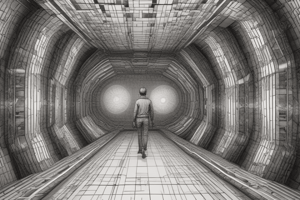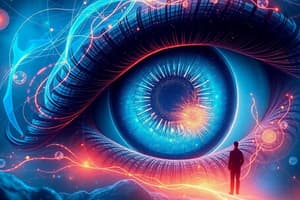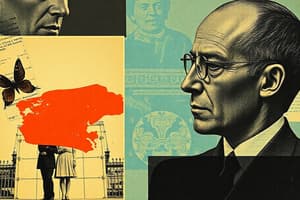Podcast
Questions and Answers
What is the role of the crystalline lens in the eye?
What is the role of the crystalline lens in the eye?
- To focus light onto the retina (correct)
- To convert light into neural impulses
- To regulate the size of the pupil
- To store photoreceptors for color vision
What are the two types of photoreceptors in the retina?
What are the two types of photoreceptors in the retina?
- Rods and cones (correct)
- Cones and cells
- Rods and lenses
- Rods and fibers
Which part of the retina is responsible for the most acute vision?
Which part of the retina is responsible for the most acute vision?
- Iris
- Fovea (correct)
- Optic disc
- Periphery
What does Gibson's theory of direct perception emphasize?
What does Gibson's theory of direct perception emphasize?
In template matching theories, what is required for recognition?
In template matching theories, what is required for recognition?
What type of vision do rods primarily support?
What type of vision do rods primarily support?
How are the electrochemical impulses formed in the retina?
How are the electrochemical impulses formed in the retina?
What characterizes feature-matching theories?
What characterizes feature-matching theories?
What is the configural-superiority effect?
What is the configural-superiority effect?
Which theory explains how we form stable 3-D mental representations of objects?
Which theory explains how we form stable 3-D mental representations of objects?
What are geons according to Irving Biederman's theory?
What are geons according to Irving Biederman's theory?
What does the word-superiority effect indicate?
What does the word-superiority effect indicate?
What does a viewer-centered representation entail?
What does a viewer-centered representation entail?
What effect does the object-superiority effect refer to?
What effect does the object-superiority effect refer to?
What role do edges play in the recognition of objects?
What role do edges play in the recognition of objects?
What is a misconception about the recognition-by-components theory?
What is a misconception about the recognition-by-components theory?
What is the primary function of the image demons in the Pandemonium Model?
What is the primary function of the image demons in the Pandemonium Model?
Which demons in the Pandemonium Model are responsible for matching features to stimuli?
Which demons in the Pandemonium Model are responsible for matching features to stimuli?
What role do cognitive demons play in the Pandemonium Model?
What role do cognitive demons play in the Pandemonium Model?
What is the function of the decision demon in the Pandemonium Model?
What is the function of the decision demon in the Pandemonium Model?
What does the term 'Pandemonium' signify in the context of the model?
What does the term 'Pandemonium' signify in the context of the model?
Which aspect does NOT contribute to the percepts in the Pandemonium Model?
Which aspect does NOT contribute to the percepts in the Pandemonium Model?
Which of the following best describes context effects in perception according to the Pandemonium Model?
Which of the following best describes context effects in perception according to the Pandemonium Model?
How do cognitive demons determine which patterns to shout?
How do cognitive demons determine which patterns to shout?
What does the top-down theory of perception emphasize?
What does the top-down theory of perception emphasize?
In constructive perception, what is primarily built by the perceiver?
In constructive perception, what is primarily built by the perceiver?
What is the overarching law of the Gestalt approach?
What is the overarching law of the Gestalt approach?
Which principle describes how we perceive objects as being distinct from their backgrounds?
Which principle describes how we perceive objects as being distinct from their backgrounds?
What does the principle of symmetry state regarding visual perception?
What does the principle of symmetry state regarding visual perception?
Which principle focuses on the tendency to perceive elements that are close together as a group?
Which principle focuses on the tendency to perceive elements that are close together as a group?
What does a landmark-centered representation rely on?
What does a landmark-centered representation rely on?
What does the configurational system specialize in recognizing?
What does the configurational system specialize in recognizing?
What characterizes the feature analysis system in pattern recognition?
What characterizes the feature analysis system in pattern recognition?
What does prosopagnosia indicate about brain function?
What does prosopagnosia indicate about brain function?
Which term describes the phenomenon when perception of an object remains constant despite changes in sensory information?
Which term describes the phenomenon when perception of an object remains constant despite changes in sensory information?
What is the role of the fusiform gyrus according to the expert-individuation hypothesis?
What is the role of the fusiform gyrus according to the expert-individuation hypothesis?
Which type of neurons in the brain specializes in depth perception?
Which type of neurons in the brain specializes in depth perception?
Where in the brain is damage likely to cause simultagnosia?
Where in the brain is damage likely to cause simultagnosia?
What is a potential cause of agnosias according to the content?
What is a potential cause of agnosias according to the content?
Which type of constancy occurs when our perception of an object's size remains constant despite changes in distance?
Which type of constancy occurs when our perception of an object's size remains constant despite changes in distance?
Study Notes
Object Recognition
- Configural-Superiority Effect: Objects in configurations are easier to recognize than objects in isolation, even if the objects in the configurations are more complex.
- Object-Superiority Effect: A target line that forms part of a 3D object is identified more accurately than a target that forms part of a disconnected 2D pattern.
- Word-Superiority Effect: It's easier to identify a single letter in a string of letters if the string makes sense and forms a word instead of being just a nonsense sequence of letters.
Recognition-by-Components Theory
- Explains how we form stable 3D mental representations of objects.
- We recognize objects by decomposing them into simple geometric shapes called geons (geometrical ions).
- Geons can be recomposed into alternative arrangements.
Vision & Light
- Pupil: The opening in the center of the iris that allows light to pass through.
- Crystalline Lens: Focuses light that passes through the pupil.
- Vitreous Humor: Gel-like substance that fills the majority of the eye.
- Retina: Electromagnetic light energy is converted into neural electrochemical impulses.
- Fovea: Small, thin region of the retina where vision is most acute.
- Photoreceptors: Cells in the retina that convert light energy into electrochemical energy.
- Rods: Long and thin photoreceptors responsible for vision in low light.
- Cones: Short and thick photoreceptors responsible for color perception.
- Optic Nerve: Axons of ganglion cells in the eye form the optic nerve.
- Optic Chiasma: The point where the optic nerves of both eyes join at the base of the brain.
Perceptual Theories
- Gibson's Theory of Direct Perception (Ecological Perception): The information in our sensory receptors, including the sensory context, is all we need to perceive anything.
- Template Matching Theories: We recognize patterns by comparing them to highly detailed models stored in memory.
- Feature-Matching Theories: We match features of a pattern to features stored in memory, rather than matching a whole pattern to a template or prototype.
Pandemonium Model
- A feature-matching model that suggests perception is noisy and chaotic.
- Image Demons: Receive a retinal image and pass it on to feature demons.
- Feature Demons: Shout out when matches are made between the stimulus and a given feature.
- Cognitive Demons: Shout out possible patterns stored in memory based on the features.
- Decision Demons: Listen to the cognitive demons and decide on what has been seen.
Top-Down Theories
- Perception is driven by high-level cognitive processes, existing knowledge, and prior expectations.
- Constructive Perception: The perceiver builds a cognitive understanding of a stimulus.
- Percepts: Are based on sensory data, knowledge stored in memory, and inferences made through cognitive processes.
Context Effects
- The surrounding environment influences perception.
- Viewer-Centered Representation: An individual stores the way the object looks to them.
- Object-Centered Representation: An individual stores a representation of the object independent of its appearance to the viewer.
Landmark-Centered Representation
- Information is characterized by its relation to a prominent item.
Gestalt Laws of Perception
- Law of Prägnanz: We tend to perceive any given visual array in the simplest way that organizes elements into a stable and coherent form.
- Figure-Ground Perception: Distinguishing the figure from the background.
- Proximity: Elements close to each other are perceived as belonging together.
- Similarity: Similar elements are grouped together.
- Continuity: We follow a continuous path or line when we perceive objects.
- Closure: We tend to perceive complete figures even when parts are missing.
- Symmetry: We tend to perceive objects as symmetrical.
- Principle of Symmetry: Features appear balanced around a central axis or point.
Pattern Recognition System
- Feature Analysis System: Specializes in recognizing parts of objects and assembling them into wholes.
- Configurational System: Specializes in recognizing larger configurations, not analyzing parts of objects.
Expert-Individuation Hypothesis
- The fusiform gyrus is activated when examining items with which one has visual expertise.
Prosopagnosia
- Inability to recognize faces.
- Implies damage to the configural system.
The Role of the Environment
- Perceptual Constancy: Our perception of an object remains the same even when our proximal sensation of it changes.
- Size Constancy: Our perception of an object's size remains stable even when its distance from us changes.
- Shape Constancy: Our perception of an object's shape remains stable even when its orientation or perspective changes.
Agnosias and Ataxias
- Agnosia: Difficulty perceiving sensory information.
- Simultagnosia: Inability to perceive more than one object at a time.
- Agnosias often occur due to damage to the border of the temporal and occipital lobes.
Studying That Suits You
Use AI to generate personalized quizzes and flashcards to suit your learning preferences.
Related Documents
Description
Test your understanding of object recognition theories, including the configural-superiority and object-superiority effects. This quiz also covers recognition-by-components theory, highlighting how we perceive and categorize objects. Explore the intricate relationship between vision and light in regards to perception.




